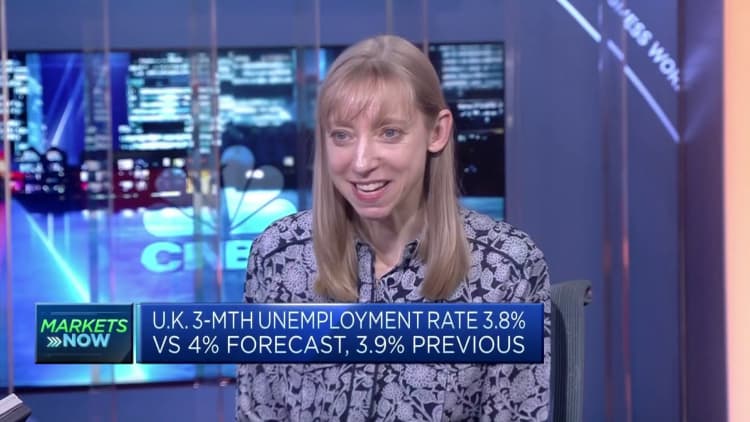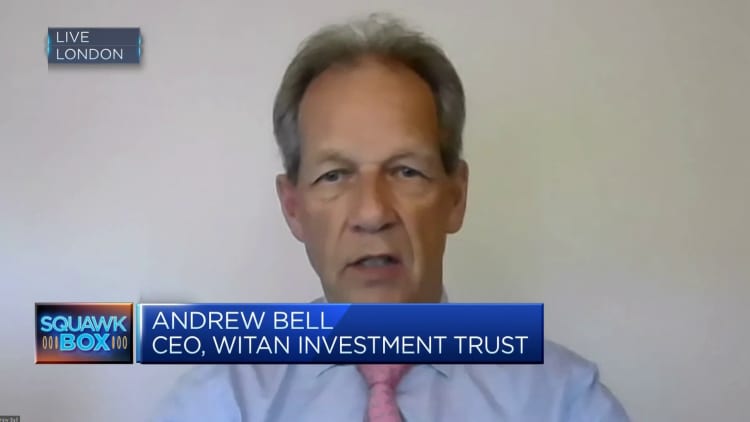A member of the public walks through heavy rain near the Bank of England in May 2023.
Dan Kitwood | Getty Images News | Getty Images
LONDON — The Bank of England is “caught between a rock and a hard place” as it prepares for a key monetary policy decision against a backdrop of sticky inflation and a tight labor market, economists say.
May’s consumer price index figure will be published Wednesday morning, the day before the Bank’s Monetary Policy Committee (MPC) announces its next move on interest rates.
Data points since the last meeting have indicated persistent tightness in the labor market and strong underlying inflationary pressures, alongside mixed but surprisingly resilient growth momentum.
Economists therefore now expect the Bank to prolong its tightening cycle and lift interest rates to a higher level than previously anticipated.
British 2-year government bond yields rose to a 15-year high of 5% on Monday ahead of the expected announcement of yet another 25 basis point rate increase on Thursday.
Since November 2021, the the central bank has embarked on a series of hikes to take its base rate from 0.1% to 4.5%, and market pricing now suggests it may eventually top out at 5.75%.
Headline CPI inflation came in at 8.7% year-on-year in April, down from 10.1% in March, but core CPI (which excludes volatile energy, food, alcohol and tobacco prices) increased by 6.8% compared to 6.2% the previous month.
The Organization for Economic Cooperation and Development projected earlier this month that the U.K. will post annual headline inflation of 6.9% this year, the highest level among all advanced economies.

Adding to policymakers’ collective headache, labor market data last week came in far stronger than expected. Unemployment defied expectations to fall back to 3.8% while the inactivity rate also fell by 0.4 percentage points.
Regular pay growth (excluding bonuses) was 7.2% in the three months to the end of April compared to the previous year, also exceeding consensus forecasts. Growth in regular private sector pay, the Bank’s key metric, hit 7.6% year-on-year.
In terms of economic activity, May PMIs moderated slightly below consensus but remained in expansionary territory, and U.K. gross domestic product unexpectedly contracted by 0.3% month-on-month in March before rebounding partially with 0.2% growth in April.
Terminal rate forecasts raised
In a research note Thursday, Goldman Sachs Chief European Economist Sven Jari Stehn said that although some uncertainty remains over Wednesday’s CPI release, there is a “high hurdle” for the Bank of England to deem it necessary to step up its hiking increments to 50 basis points.
Stehn highlighted that “inflation expectations have remained anchored, recent comments have signalled no appetite for stepping up the pace and the meeting will have no press conference or new projections.”
“We look for the MPC to retain its modal assessment that underlying inflation pressures will cool as headline inflation declines but acknowledge the firmer recent data and note that risks to the inflation outlook remain skewed significantly to the upside. We also expect the MPC to keep its loose forward guidance unchanged,” Stehn added.
Goldman Sachs expects the MPC to retain its relatively dovish position given resilient growth, sticky wage pressures and high core inflation, and to continue being pushed into more 25 basis point hikes by stronger-than-expected data, eventually reaching a terminal rate of 5.25% with risks skewed upside.
BNP Paribas economists also expect a 25 basis point hike on Thursday, as inflation expectations remain lower than they were when the Bank was lifting rates in 50 basis point increments last year.

The French lender also upgraded its terminal rate forecast to 5.5% in a note last week, from 5% previously, in response to “clear evidence of more persistent inflation.”
Though the tightening cycle is expected to be longer than higher in order to reel in inflation, BNP Paribas suggested the MPC would be “wary of over-tightening” and will be looking to gauge how rate rises to date affect households, particularly as fixed-rate mortgage renewals roll in through the second and third quarter.
U.K. mortgage borrowers are being pushed to the brink as rising borrowing costs hit deal renewals and products are pulled from the market.
Laith Khalaf, head of investment analysis at AJ Bell, said the MPC is “caught between a rock and a hard place” as it chooses between pushing more mortgage borrowers to a cliff edge and allowing inflation to run riot.
“Current interest rate pricing reflects alarm bells ringing in the market, but some moderation in inflationary pressures over the summer would pour balm on the situation. The Bank of England will also be cognisant of the fact the full force of its tightening to date is still working its way through the economy,” Khalaf said.
“Having said that, should inflation data remain ugly, the Bank will be under pressure to take action, and so will the Treasury, if it looks like the Prime Minister’s pledge to halve inflation is at risk of falling short.”
 EU News Digest Latest News & Updates
EU News Digest Latest News & Updates



